The Contemporary Masters
Fashion with a sustainable and ethical focus
Based in New York, Ingrid has developed a unique, limited-edition set of handbags using creative combinations of up-cycled furs and leathers. She approaches fashion with a sustainable and ethical focus. In addition to the up-cycled vintage fur coats, Ingrid uses leathers (embossed cowhide and lambskin only).
Vintage Sustainable Fashion
Creating combinations with wool, palm, recycled leathers, suede, velvet, old coins, gold foil, silver, feathers, jute laces, and recyclable cotton, hand-painted and embroidered pieces, Mayra Morán has created her signature MAIAHATS (hat design), valuing crafts, design and materials always considering a “sustainable” purpose.
Sustainability and Innovation
Marcella Echavarria is a designer and cultural entrepreneur who has dedicated her career to the study of textiles, craftsmanship, tradition and sustainability. She has worked with artisan communities across the globe, from Tibet to San Pedro Cajonos, in a quest to preserve and document ancestral techniques as global heritage.
Design & Architecture
Luis Guillermo Pons is an award-winning designer and the founder of Luis Pons Design Lab, an architecture and design firm based in Miami, Florida. He is “interested in design that really speaks to people who want to engage in a conversation with it, design whose ultimate purpose is revealed by the user, design that allows for the possibility of change.”
Fomento Cultural Banamex
Fomento Cultural Banamex is a non-profit organization whose mission is to promote investment in cultural development, as well as to promote, preserve and disseminate Mexican culture.
Since its creation, Fomento Cultural Banamex has had the vision of being a recognized example of a private company that promotes Mexican culture with leadership, through innovative actions and in accordance with the needs of the country and the National Bank of Mexico.
Unique and Avant-garde Masterpieces
Adrián Gómez and Enderson Pérez are the two architects behind the KAUSLAB proposal, the “laboratory of the brightest star”. Inspired in by the stars that gave light and bases to the beginnings of architecture, Adrián Gómez Art offers a variety of unique, avant-garde, and innovative home décor pieces and more, handmade by artisans in Merida – Yucatan.
Environmentally Responsible Handbags
Fashionable and timeless silhouettes. DOIZPE creates handbags that are environmentally responsible made from cactus and vegan leather, inspired by the beliefs and personal experiences of the designer, Dora Izquierdo. The handbags are created by a factory in Mexico that produces vegan leather, and which is also responsible with the environment by lowering 30% their carbon emission volumes.
Casilda Mut
Positive Social Impact through Fashion
Casilda represents us women. Mut means “Bird” in Tzotzil, a language native to the Highlands of Chiapas. Casilda Mut aims to generate a great commitment to the development and growth of the indigenous communities of the region and the positive collaboration with them, a common denominator of the entire team that now makes up Casilda Mut in San Cristóbal de las Casas, Chiapas.
The Great Masters
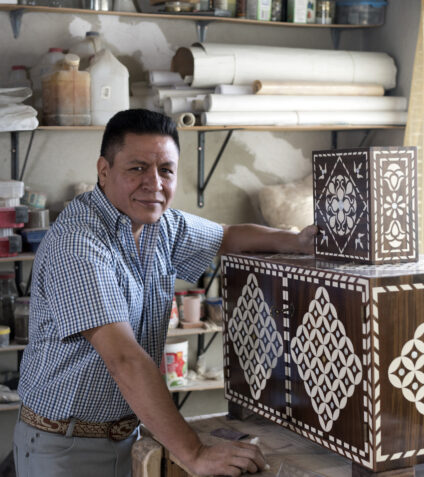
René Ángeles Navarro
The Greatest Expression of Popular Art.
Born in Santa María Ajolopan in the State of México and currently based in Naucalpan, self-taught artisan Rene Angeles Navarro uses red cedar, walnut, and ashwood, among other woods, in creating his painstaking inlay work. He combines elements from antiques with shapes and figures of his own inspiration. “Using antique elements as a point of reference is reflected not only in a harmonious composition but also in the identity of a people, a region, a country.”
Rene’s fine craftsmanship has been the object of numerous awards and prizes. His work was on display in exhibitions of folk art organized by Fomento Cultural Banamex in Mexico and Latin America and has been featured in books of this organization published in 1998 and 2012.
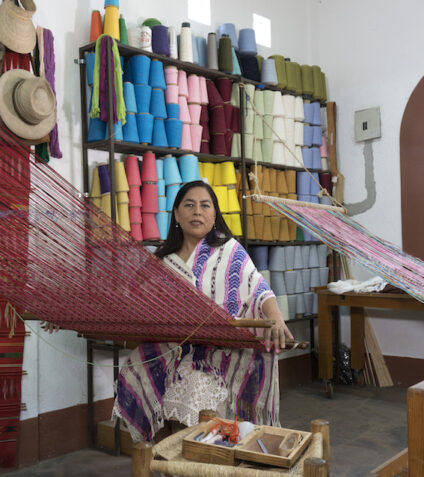
Camelia Ramos Zamora
The Legacy of Mexican Textiles
Based in Malinalco, a small town a few hours away from Mexico City, Camelia Ramos elaborates magnificent shawls out of 100% cotton thread, dying them with nothing but natural materials, such as cochineal grana, walnut shell, cordelina pomegranate, smoke ink, metal oxide, indigo, lama, and red stick, among others.
Her father, Isaac, winner of the 2008 National Prize for Popular Art taught her everything she knows about this craft.
Camelia says that one of the most important days of her life was when her father told her: “I am leaving with the satisfaction of having taught you what I learned as a child with my family. I want you to commit to continuing this legacy”.
Camelia has also been recognized with several awards and has participated in various exhibitions both in the country and abroad, where she has highlighted the art of Mexican textiles with her fine and elegant shawls.
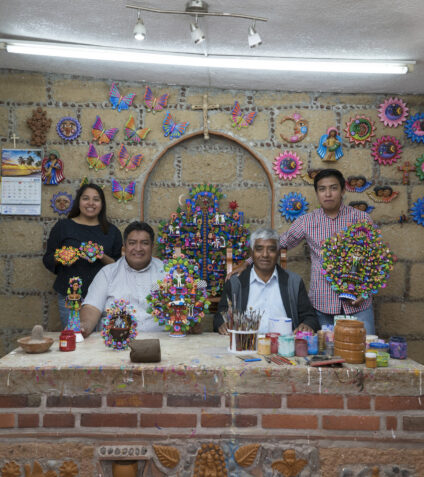
Alfonso and Óscar Soteno
“Each Tree of Life represents my perseverance towards creating these pieces a greater scale.”
Óscar Soteno Elías has his own workshop, where he creates magnificent trees of life. His pieces are the most superb expressions of clay craftsmanship, in which he has managed to develop an enormous variety of unique subject matter, while honing an exquisite, meticulous, refined technique that denotes the degree of skill he has achieved.
Alfonso and Óscar, members of this large family of renowned lineage and of enormous Prestige in Mexico and abroad. They have received hundreds of prizes and awards as some of the country’s most representative clay craftsmen.
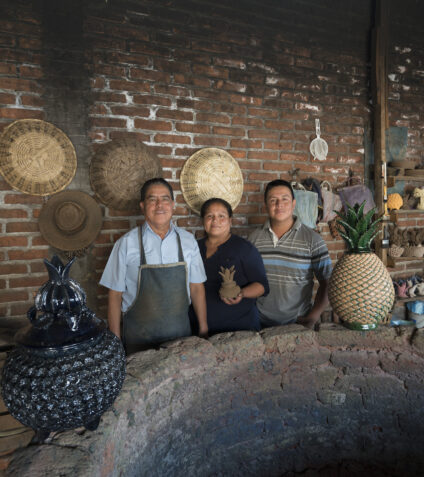
Hilario Alejos Madrigal
The Glaze Ceramic Expert
Hilario Alejos Madrigal has never seen a badly made piece. The enormous quality of his craftsmanship has been constant since he began to model and mold pieces of glazed ceramics at the age of seventeen.
In his work, he employs stones for burnishing, wood, and foil; as well as sheet metal cutters, nylon thread, a potter’s wheel, diverse molds, an open-air brick kiln, and an electric, industrial-capacity kiln.
In 1998 one of his works in the form of a barrel cactus appeared on the cover of the book Great Masters of Mexican Folk Art, published by Fomento Cultural Banamex. With this massive dissemination, his creations became known nationally and internationally and he became one of the most sought-after potters in Michoacán.
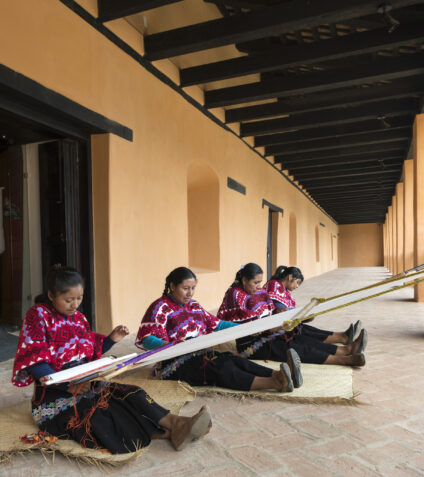
Sna Jolobil
“When I was ten, I started to save bits of cotton thread for two years, because I didn’t have money to buy my own thread. When I had collected enough to begin weaving, I then started to practice on a tiny loom. My heart yearned to acquire good technique to produce the designs.”
María Meza is one of its most noted exponents of the art of creating traditional garments, such as huipiles (tunics), enredos (wrap skirts), sashes, and ceremonial capes.
In the mid-1970s, María Meza helped create the cooperative Sna Jolobil (House of Weavers) in San Cristóbal de las Casas. Today this cooperative brings together artisans from more than thirty indigenous communities in Chiapas who invest all their efforts in the recovery and revitalization of Maya textile art, in addition to organizing courses and workshops to transmit their knowledge to the new generations, while also designing strategies to sell their textiles.
Paula Escudero Mejía (1954) lives in this town and from the time she was a little girl she helped her parents make the maque (lacquer) and apply it. She not only learned to prepare this base coat, but also to enjoy the task. When she was nineteen she married Dám aso Ayala Jiménez (1950–2014), named a Great Master of Mexican Folk Art by Fomento Cultural Banamex in 1996.
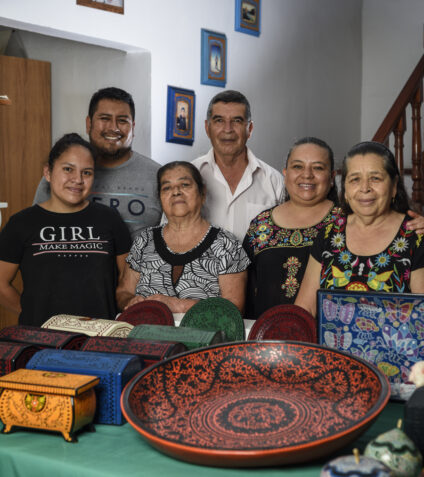
The Escudero Family
At the highest reaches of the state of Guerrero, in the region known as “La Montaña,” is a remote locality whose very name evokes a unique aroma known worldwide. The fragrance comes from the Wood of the linaloe (Bursera linanoe) tree, and the town is Olinalá, renowned for the remarkable objects made by expert artisans engaged in a centuries-old art. They apply this type of lacquer work to gourds and wood; one of the specialties is laca rayada, a technique of incising and cutting away one layer of lacquer to reveal another in a contrasting color.
The Escudero family’s rayada work is highly renowned in this area and in the entire country. Their pieces are based on six essential animals, all with pre-Hispanic connotations: rabbits, felines (jaguars), birds, butterflies, herons, and deer. Their geometric designs single out their workshops, well-known for the quality and type of decoration they all employ, produced with delight in seeing their magnificent final products.

